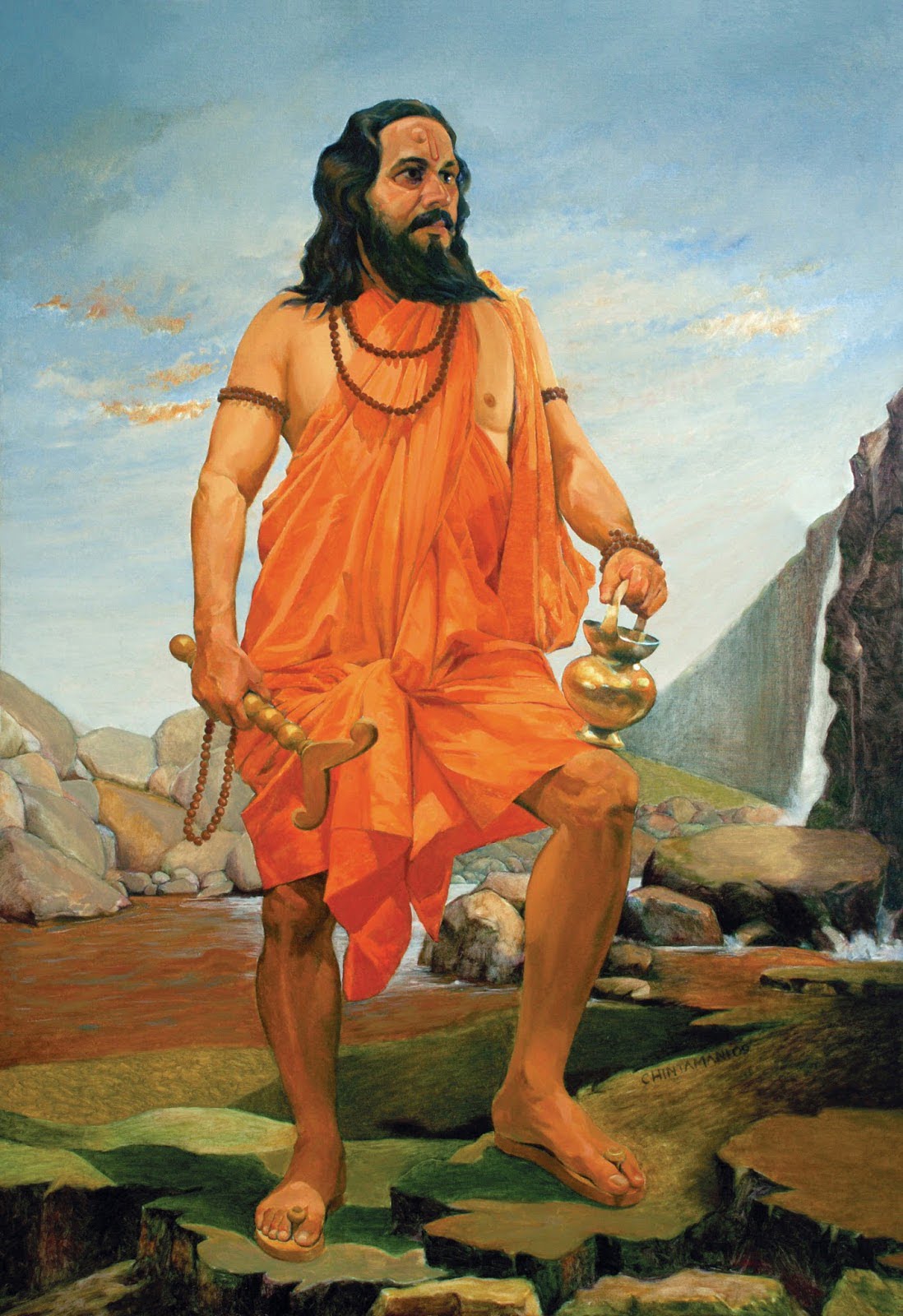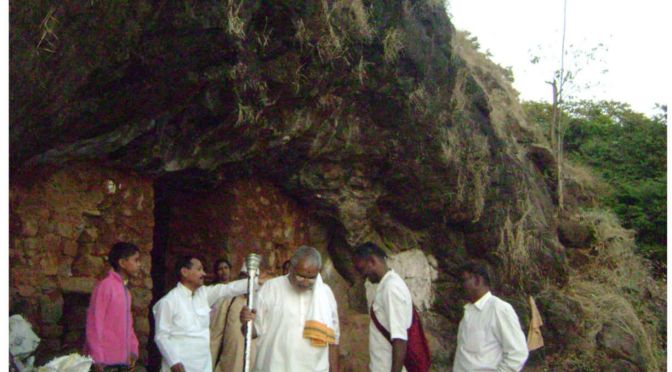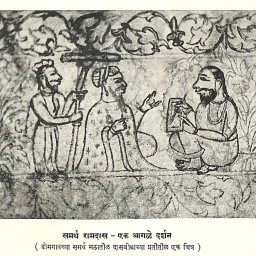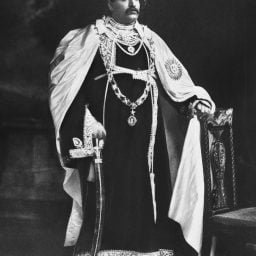There was once a Sant (saint) who lived in the western region of Bharat (Maharashtra, India) in the 17th century. Being aware of various atrocities and religious persecutions inflicted by the Malech rulers (मलेच्छ: foreigner or barbarous) like Aadilshahi, Qutubshahi, and Mughals. He advocated Balopasana ( बलोपासना: praying/focussing on strength) amongst the general public with the intention of raising fitness consciousness in people so that they can participate in establishing a swarajya (self-rule) for their safety. He understood the protection of the people can only happen under the Swarajya, a self-rule that he recognised Chatrapati Shivaji Maharaj was endevouring to establish.
But one day swaraj was under threat; a malech leader from Adil Shahi called afzal khan took charge of killing Ch. Shivaji Maharaj. With his army, he attacked the country, inflicted torture on citizens, and desecrated temples as he progressed from Bizapur to Maharaj.
In response to this crisis, the Sant turned to his deep-seated faith, invoking the blessings of Shri Ganesh, the ‘destroyer of obstacles’ विघ्नहर्ता. He pleaded for the eradication of this trouble in his prayer.

His prayers culminated in the composition of the Aarti (hymn), which has since become a cornerstone of devotion, chanted by millions.
As history unfolds, the prayers of the Sant were not in vain. For in the battle of wits and wills, it was the valor of Ch. Shivaji Maharaj that triumphed, saving the swarajya.
Who is this Sant? And which powerful Aarti is being referred to in this lore?
From the title you might have easily guessed that this empowering Aarti is none other than सुखकर्ता दुःखहर्ता- Sukhkarta Dukhharta, a श्री गणेश आरती-Shri Ganesh aarti that is being sung all over Maharashtra and beyond.
Who wrote this aarti? The hint is provided within the Aarti itself as the poet has signed his name within the final verse of the aarti.
...दास रामाचा वाट पाही सदना, संकटी पावावे ..
Servant of Ram is waiting for you in the sadan(house)
“दास रामाचा” which means servant of Ram refers to Sant Ramdas itself whose name “रामदास” means Ram’s Servant. A beautiful interplay of words, isn’t it?
This prayer was created, first composed, and sung by संत श्रेष्ठ समर्थ रामदास स्वामि-Sant Shreshth SAMARTH RAMDAS SWAMI.
सुखकर्ता दुखहर्ता, वार्ता विघ्नांची नुरवी|
पुरवी प्रेम, कृपा जयाची|
सर्वांगी सुंदर, उटी शेंदुराची|
कंठी झळके माळ, मुक्ताफळांची॥१॥
जय देव, जय देव जय मंगलमूर्ती| दर्शनमात्रे मन कामना पुरती ॥धृ॥
An accurate translation:
O effectuator of satisfaction, destroyer of sorrow, Let the news of trouble be no more.
Provide us love; favour of victory
The entire body is beautiful, coated with sindoor.
Glittering from the neck, a pearl garland.
Chorus
Hail God, Hail God! Hail your auspicious form. mere sight of yours fulfills all desir
रत्नखचित फरा, तुज गौरीकुमरा|
चंदनाची उटी, कुमकुम केशरा|
हिरेजडित मुकुट, शोभतो बरा |
रुणझुणती नूपुरे, चरणी घागरिया|
जय देव जय देव जय मंगलमूर्ती ॥२॥
Gem-studded Phara (“फरा Phara”—a peepal leaf-shaped ornament tied to the forehead) on you, the Gauri’s Son.
Sandal’s utti (a cosmetic blend) on forhead with a kumkum tilak made of saffron.
A diamond-studded crown shows much grace.
Tinkling anklets and ghagari adorning the feet.
लंबोदर पीतांबर, फणिवरबंधना |
सरळ सोंड, वक्रतुंड त्रिनयना|
दास रामाचा, वाट पाहे सदना|
संकटी पावावे, निर्वाणी रक्षावे, सुरवरवंदना|
जय देव जय देव, जय मंगलमूर्ती|
दर्शनमात्रे मनकामना पुरती ॥३॥
Large belly, covered in yellow silk Dhoti, and tied with a Cobra-hood-designed waist belt.
Uncurved trunk, curved face with three eyes.
Servant of Ram is waiting for you in the sadan (house),
intervene in the crisis and protect us from annihilation. Supreme amongst Dev-Gan prays to you.
Chorus
Hail God, Hail God! Hail your auspicious form. mere sight of yours fulfills all desires.`ddev
Isn’t it strange that, although a significant part of the population has been hymning this aarti almost every day, only a few realize the name of the poet is embedded within the last verse. But that doesn’t end here; there is a deeper layer to the aarti, which is not obvious by simple translation. It requires you to understand लोक-काल-देश (people, period, country) during Sant Samarth Ramdas time.


In 1658, Samarth left the ghali (cave) of Shivthar to go to Nashik for the Kumbh Mela. The year is mentioned as आनंद संवत्सर(Anand Samvatsar) in the written records. While he was in the valley, he heard the news of trouble (वार्ता विघ्नाची)— afzal khan’s invasion of the land.
The opening line of the Aarti refers to this very attack,
सुखकर्ता दुखहर्ता वार्ता विघ्नाची न उरवी,
O effectuator of satisfaction, destroyer of sorrow, Let the news of trouble be no more.
and it is a poignant plea for the eradication of troubles, symbolizing the collective hope of a nation under siege.
‘वार्ता (Varta): news
विघ्नाची (Vighnachi): of Trouble
न उरवी(Nurvi): not remain/survive
Similarly, in the final verse ,
दास रामाचा वाट पाही सदना,
संकटी पावावे निर्वाणी रक्षावे सुरवरवंदनाServant of Ram is waiting for you in the sadan(house), intervene in the crisis and protect us from annihilation(निर्वाणी)
.
“संकटी पावावे निर्वाणी रक्षावे”. निर्वाण in this context means annihilation or extinction. Sant Ramdass is pleading with Shri Ganesh to intervene in crisis (संकटी) and protect us from annihilation (निर्वाणी रक्षावे).
This line, in particular, serves as a historical reference to the dire situation of the time, encapsulating the essence of the challenges faced and the fervent wish for divine intervention.
This lore might seem far-fetched, and some might say that I am reading too much between the lines.
- But Samarth Ramdas himself mentions multiple times that he went and prayed to Shri Ganapati after witnessing atrocities in another composition, “आनंदभूवणी Anandbhuvani.”. Aanandbhuvani is In the same composition, he also refers to the vanquishing of afzal khan at Pratapgad by blessing of Ramvardayini (a Goddess presiding at the foothills of Pratapgad)
Later in the year 1658 (आनंदसंवत्सर), when Samarth Ramdas reached Kumbh Mela, he further got to know that Afzal Khan had taken charge to kill Ch. Shivaji Maharaj, and as he progressed, he caused havoc in the country, and Shri Samarth recorded those in Anand Bhuvani (आनंदभूवणी). Below is a relevant excerpt from Anandbhuvani; try to read it with attention. If you are well versed in Hindi, Marathi, Sanskrit, or any संस्कृतनिष्ठ language, you should be able to read and understand.
जे साक्ष देखिली दृष्टी | किती कल्लोळ उठीले| विघ्न्घ्ना प्रार्थिले गेलो | आनंदवनभुवना ||८ ||
स्वधर्मा आड जे विघ्ने | ते ते सर्वत्र उठिली | लाटीलीं कुटीली देवी | दापिली कापिली बहु ||९ ||विघ्नांच्या उठिल्या फौजा | भीम त्यावरी लोटला | धर्डीली चिरडीली रागे | रडवीली बडविली बळे ||१०||हाकीली टाकिली तेणे | आनंदवनभुवनी | हांक बोंब बहु झाली | पुढे खतल मांडिले ||११ ||खोळले लोक देवाचे | मुख्य देवची उठिला | कळेना काय होते रे | आनंदवन भुवनी ||१२ |
- In verse 8: “किती कल्लोळ उठीले| विघ्न्घ्ना प्रार्थिले गेलो |”,
Shri Samarth says How much tumult caused, I went to pray to Shri Ganesh (विघ्न्घ्ना प्रार्थिले गेलो): A direct reference to Sukhkarta Dukhharta Aarti.
Of course, it was a strategic move, and desecration of temples must have affected Maharaj, but Chatrapti did not let anger get the better of him into making a rash decision.
- The hymn “Sukhkarta Dukhharta” was composed by Samarth Ramdas at Shivthar Ghal, also known as Sundar Math, and referred to as Anand Bhuvan in his literature.
- The proximity of Samarth Ramdas: During the events of Pratapgad and killing of afzal khan ( year 1659) was in Anandbhuvani, which is a mere 65 kms from Pratapgad (google maps)
Closing thought
Of-course, we can never be fully certain with this Lore until a few more triangulation references are established. However, unlike other contemporary saints, Shri Samarth Ramdas was actively involved in martial, political, and social activism in his time, and that was reflected in his literary works, discourses, and actions.
- He has been known for recording contemporary historical events around him in his compositions, and we cannot deny the possibility that he has created Aarti for Shri Ganesh with reference to overcoming one such calamity.
- Unlike the other contemporary period saints, Ramdas is not deemed a pacifist, and his writings include strong expressions encouraging militant means to counter the aggressive Muslim invaders.
- His advocacy for Balopasana, where he has highlighted the importance of physical strength and knowledge towards individual development. He expressed his admiration for warriors and highlighted their role in safeguarding the society.
It is clear that the mentioned Aarti stands out from all other Aartis, including its own compositions. While it may not refer to Afzal Khan’s invasion, it undoubtedly speaks of troubling news and implores Ganpati for protection against annihilation. Perhaps it alludes to some other event of which we are not aware.
Next time, when you are praying with this aarti, try to sing the aarti from the perspective of Samarth Ramdas when he received a वार्ता विघ्नाची ask yourself these questions
- The word वार्ता(news) is of importance, विघ्नहर्ता(destroyer of obstacle) is referred to as Ganapati, but which news of trouble(वार्ता विघ्नाची) is in discussion?
- Who should get through the crisis (संकटी पावावे )?
- Whom to protect from निर्वाणि (annihilation)?
- What is Samarth waiting for (वाट पाही सदना)?
Source: Shri Ganesh Kosh by Amrendra Gadgil.
dasbodh.com
SHIVTHAR GHAL AANANDVANBHUVANI (realshivtharghal.blogspot.com)
Our profits support SaveTemples.org and Siddhagiri Math in their mission to restore and maintain neglected temples, preserving our rich heritage for future generations.






